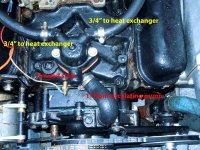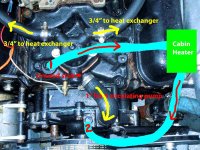Hello!
I've done a bit of searching in this forum in this topic, but wasn't able to find anything that quite matched my engines. I have a 1975 Bayliner Montego 3350 (my first boat ever) with dual Chrysler 360s, one reverse and the other standard rotation. Both are freshwater-cooled (raw water pumped through heat exchanger and then out through exhaust manifolds). I spent the last 18 months gutting the boat and rebuilding it, including a complete rebuild on both engines, as it had sat in a southeast Alaskan rainforest for the past 15 years. I'm now in the process of finishing up the interior bits and I'm looking to add both a cabin heater and a hot water heater to the coolant loop of the engines (one device on each engine). So, I have two questions:
1. Is the coolant flow reversed on the reverse rotation engine? If so, does this only apply to the circulation internal to the engine, or is the entire system reversed? The latter wouldn't make much sense to me as it would mean dumping hot coolant into the bottom of the heat exchanger and drawing from the top, so I'm guessing that only the internal circulation would be affected, if at all. This whole question may be pointless.
2. How should I plumb the coolant loop for the cabin heater and hot water heater? My thermostat housings each have two outputs to the heat exchanger (I assume the second one is for when the thermostat actually opens, but I could be wrong). These are the two 3/4" hoses labeled in the attached photo. There's also a 1" hose coming from the top of the circulating water pump housing to the intake manifold just below the thermostat housing (also labeled in the photo). Finally, on just one engine only, there's an unused stub on the thermostat housing itself.
My first thought was to go from the thermostat housing to the cabin heater, and then back down to the heat exchanger, because everything used 3/4" hose and I wouldn't have to do any size adapting. The problem there is that it creates a pressure imbalance (35' round trip run) to the point where no coolant will actually circulate through the long loop, but rather it all gets forced through the shorter route. An inline circulating pump would solve that problem, but I'm not convinced that's the way to go, and I suspect I would have to pick very carefully which thermostat output I pick. Plus, it's just another piece of equipment to fail.
The other option would be to go direct from the larger outlet on the top of the circulating pump, loop through the cabin heater, and then back to the intake manifold just below the thermostat housing. This would require reducing the 1" down to 3/4" at some point. This is easy enough to do, but would this substantially affect the coolant flow in a negative way?
Any help would be greatly appreciated!

I've done a bit of searching in this forum in this topic, but wasn't able to find anything that quite matched my engines. I have a 1975 Bayliner Montego 3350 (my first boat ever) with dual Chrysler 360s, one reverse and the other standard rotation. Both are freshwater-cooled (raw water pumped through heat exchanger and then out through exhaust manifolds). I spent the last 18 months gutting the boat and rebuilding it, including a complete rebuild on both engines, as it had sat in a southeast Alaskan rainforest for the past 15 years. I'm now in the process of finishing up the interior bits and I'm looking to add both a cabin heater and a hot water heater to the coolant loop of the engines (one device on each engine). So, I have two questions:
1. Is the coolant flow reversed on the reverse rotation engine? If so, does this only apply to the circulation internal to the engine, or is the entire system reversed? The latter wouldn't make much sense to me as it would mean dumping hot coolant into the bottom of the heat exchanger and drawing from the top, so I'm guessing that only the internal circulation would be affected, if at all. This whole question may be pointless.
2. How should I plumb the coolant loop for the cabin heater and hot water heater? My thermostat housings each have two outputs to the heat exchanger (I assume the second one is for when the thermostat actually opens, but I could be wrong). These are the two 3/4" hoses labeled in the attached photo. There's also a 1" hose coming from the top of the circulating water pump housing to the intake manifold just below the thermostat housing (also labeled in the photo). Finally, on just one engine only, there's an unused stub on the thermostat housing itself.
My first thought was to go from the thermostat housing to the cabin heater, and then back down to the heat exchanger, because everything used 3/4" hose and I wouldn't have to do any size adapting. The problem there is that it creates a pressure imbalance (35' round trip run) to the point where no coolant will actually circulate through the long loop, but rather it all gets forced through the shorter route. An inline circulating pump would solve that problem, but I'm not convinced that's the way to go, and I suspect I would have to pick very carefully which thermostat output I pick. Plus, it's just another piece of equipment to fail.
The other option would be to go direct from the larger outlet on the top of the circulating pump, loop through the cabin heater, and then back to the intake manifold just below the thermostat housing. This would require reducing the 1" down to 3/4" at some point. This is easy enough to do, but would this substantially affect the coolant flow in a negative way?
Any help would be greatly appreciated!



